How To Set Up An Aquatic Turtle Tank
BuildYourAquarium.com is supported by our readers. When y'all buy through links on our site, nosotros may earn a commission. Learn more.
This guide will take yous through every step of setting up a turtle tank, from selecting the tank to ongoing maintenance and care.
Decided to get a turtle? Great choice!
Turtles actually have a lot to offer every bit far as pets go, and they brand excellent petty companions for all types of people. They tend to be gentle and shy, notwithstanding highly interactive when they experience comfy.
Turtles are small and quiet, making them specially platonic for apartment-dwellers who want a absurd companion that doesn't bawl at the mail carrier or need to be taken out for walks.
Another not bad matter about turtles is that they generally live a very long time, upward to 30 years in some cases – certainly much longer than most household pets! Because of this, getting a pet turtle truly is a long-term commitment.
Turtles are adorable and fascinating with an assortment of unique colors, markings, and other interesting features.
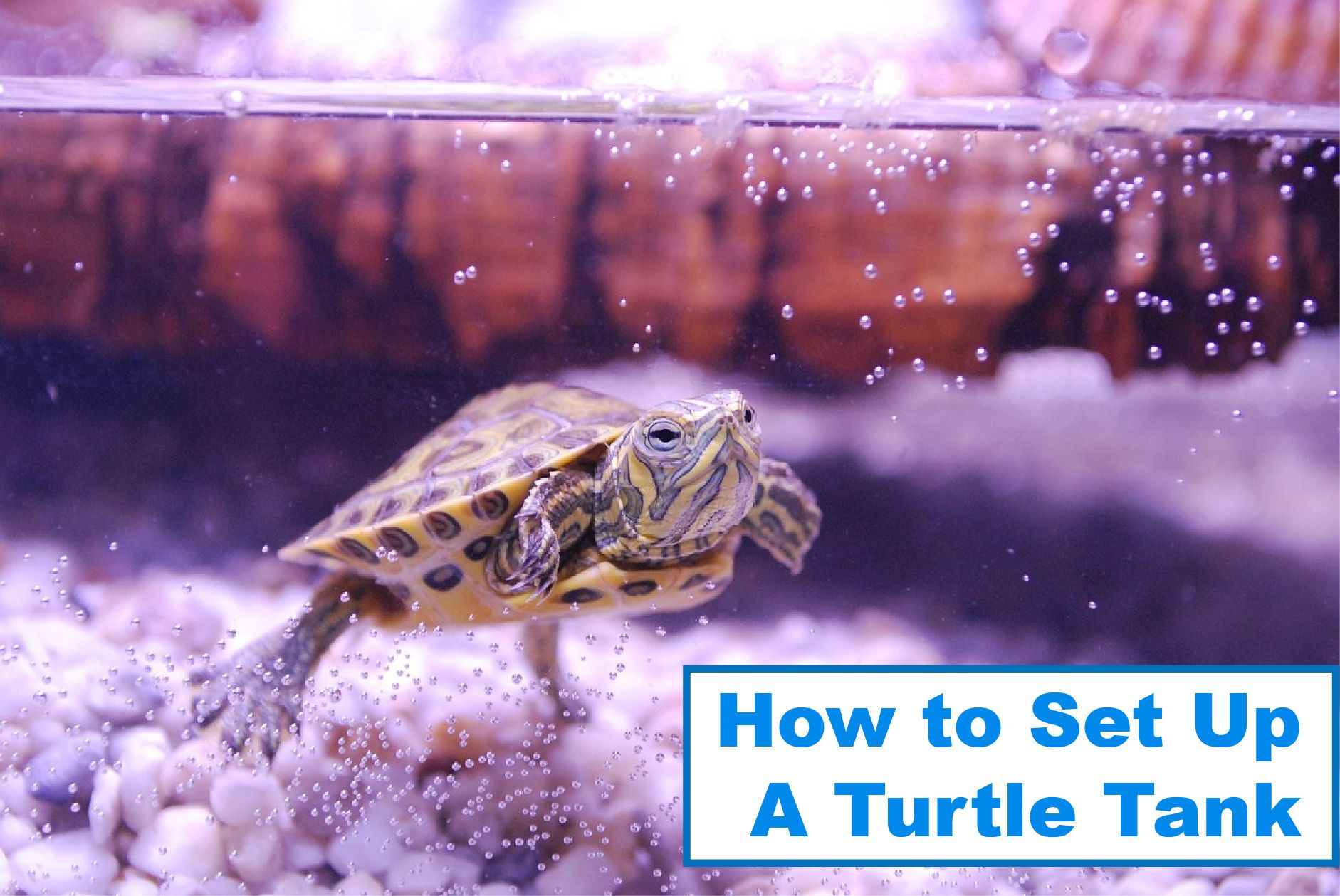
Even though turtles are generally considered to be somewhat low-maintenance, they yet crave the correct environment in order to thrive. That's your task. Giving your turtle a dandy place to call abode is function of the fun of owning ane! In fact, turtle tank building has go somewhat of a hobby unto itself, with some turtle enthusiasts taking their tanks above and across with elaborate rock arrangements, waterfalls, and other dramatic features.
Turtle habitats don't need to be fancy, as long as they take all the necessary elements. You tin can customize your turtle tank even so you like, as long every bit you're providing a healthy habitat for your niggling buddy.
Choosing the Right Tank
The first thing to do is get a tank for your new pet. Don't just grab the offset one you run across at a grand sale or pet shop, either. It's important to select just the right enclosure to brand sure your turtle has a abode that is condom and enjoyable.
Most people use glass aquariums to firm pet turtles. Plastic tubs can also exist suitable. Some turtle owner who live in warm climates even build outdoor open-air habitats.
For this guide, we'll be talking almost setting up a drinking glass tank.
First and foremost, a turtle tank needs to be sturdy and well-built. Not merely whatsoever glass enclosure will do. Reptile tanks more often than not don't work as turtle habitats because many will not reliably hold h2o. If yous're thinking well-nigh repurposing an old tank instead of buying a new i, test it out by filling information technology with water and letting it sit for a few days while you watch for leaks.
What Size Should Your Tank Be?
To thrive, turtles need enough of space to swim and explore. Here are the full general guidelines for choosing the correct size tank for yours.
- If your turtle is small (effectually 4-6 inches), you'll demand at least a 30-gallon enclosure.
- For medium-sized turtles (6-viii inches), become a 50-gallon tank – at minimum.
- To adjust a large turtle (viii inches and to a higher place), cull a 75+ gallon tank.
Bigger is better when it comes to turtle tanks. If yous're in doubt, it's unremarkably all-time to go with the bigger size. Also, keep in mind that the size recommendations in a higher place are for a fully-grown turtle. If you purchase a tank based on the size of your babe turtle, you may have to upgrade as it grows.
At that place are several reasons not to get a tank that's too small.
- It volition be harder to clean.
- It will get dirty more quickly than a larger tank.
- Your turtle volition not bask full quality of life in an enclosure that isn't big enough.
- Your pet may be unhealthy, and it might not grow to full size.
- Putting multiple turtles in a likewise-minor enclosure usually results in territorialism and fighting.
Nearly Tank Covers
Turtle tanks should always have a cover on top of them. This is to protect your turtle in a few means. Commencement, it will prevent outside objects from falling in. Plus, it helps provide a barrier between your pet and any heat or lighting sources y'all may take mounted above the tank. Finally, and just as importantly, a comprehend keeps your turtle from escaping its enclosure. Be sure to get a chapeau that interlocks with the tank or has some kind of locking mechanism so it can't be pushed off by curious turtles.
Steel mesh covers are commonly the meridian choice for turtle enthusiasts. The oestrus-proof mesh is suitable for setting heat lamps on top of, since information technology won't cook or take hold of on burn down. They besides provide enough ventilation then that your tank doesn't go too hot or humid.
Designing the Layout of Your Turtle Tank
While some aspects of designing your tank's layout are actually matters of personal gustation, there are some essential components y'all must include.
Your tank should be divided into two areas, an underwater infinite where your turtle will likely spend about of its time too as an above-water basking area.
Underwater Expanse
At least half of your tank should be underwater. As aquatic and semi-aquatic animals (depending on the exact species), turtles need to swim and play underwater every day to be happy and healthy.
Above Water Surface area
The rest of your tank should exist used for an above-water space where your turtle can dry out and bask (more nigh basking in a moment). If you have an aquatic turtle, you only demand to dedicate most 25% of the total tank space to the above-h2o area. For semi-aquatic turtles, this dry surface area should take upwardly about half of the space in the tank.
Some tanks come ready-made with designated areas for your moisture and dry out zones. You tin also use rocks or logs, as well as pre-fabricated ramps and platforms to configure these spaces yourself. If you programme to do it yourself, it can exist helpful to make a sketch of how you plan to ready up your tank. It's also a great thought to look around online and check out some of the ways other people have set their turtle habitats upward.
Gathering the Necessary Equipment
Once y'all have an idea of the way you'll lay out the elements of your tank, it'southward time to make your shopping listing and gather up all the little things y'all'll need to get going.
Turtle Tank Filters
A good filtration system is admittedly necessary for the cleanliness of your tank, and the health of your pet. Turtle tank water can go dirty chop-chop. This isn't just cruddy. Information technology's also not good for your turtle.
Your filter will clean up old food, excrement from your turtle, and whatever other unwanted droppings floating around in the aquarium. Information technology also removes harmful substances that are past-products of those waste items.
Canister Filters
Nigh often, canister filters are used for turtle tanks. They tend to work very well, fifty-fifty for large tanks. These are commonly mounted nether the tank and can be curtained by a stand up or cabinet. Canister filters are multi-stage filtration systems. This means that they contain layers of different filtration media, which we'll talk about in a few paragraphs.
Internal Filters
Internal filters, likewise called submersible filters, can be placed inside the tank. They unremarkably attach to the walls of your aquarium with suction cups. These filters tend to exist small, and are only suitable for smaller tanks. Internal style filters tin can also be multi-stage filters, though in that location are limitations to the number of stages they can contain due to their size.
HOB Filters
HOB stands for "hang on back." This kind of filter is, as you might have guessed, hung on the dorsum of a tank. Because this kind of filter is designed specifically for use in fish tanks, you may have to take special care if you desire to use one for your turtle habitat. Since turtle tanks aren't filled all the way with h2o the manner fish tanks are, your tank volition need a filter cutout to accommodate an HOB. Another thing to continue in mind with HOBs is that you'll have to buy ane that'due south rated for a larger tank than you lot're actually using. This is considering turtles produce waste material at a higher rate than fish, so fish tank-based size ratings aren't authentic.
UGFs
UGF is an acronym for Under Gravel Filter which is placed, similar it sounds, underneath gravel substrate in a tank. While many turtle enthusiasts practise not recommend these, there are some who swear by them. This kind of filter is installed on the tank floor, below a layer of gravel. Water is pulled through the gravel, which serves every bit function of the filtration system, earlier reaching the main filter. There are a couple unlike types of UGFs to choose from, but all work in substantially the same mode. This kind of filter could exist problematic for a turtle that likes to dig.
No matter what type or make of filter you lot choose, make sure it's designed to work with the size of tank y'all have. You can get the best filter on the market place, but if it'due south only rated for a 50-gallon tank and you have a 100-gallon tank, it's non going to practice a great job for you lot.
About Filter Media
Filter media is whatever materials are inside your filter. Each layer of a filter contains a different medium, which the dirty water passes through on its way to becoming clean. Some things that you might find in a multi-stage filter include sponges, activated charcoal, ceramic rings, lava rock, polyfill or fiberfill floss, and Bio Assurance (specially designed spheres fabricated for filtering water in aquatic habitats).
Turtle Tank Heaters
Turtles are cold-blooded, so are non able to regulate their own torso temperature. Every bit a turtle-owner, you'll be responsible for keeping your pet's habitat inside a healthy range. You will accept to monitor and regulate the temperatures in both the wet and dry portions of the tank.
Here is our recommended heater for turtle tanks:
Heating the H2o
The optimal h2o temperature for turtles is generally betwixt 74-82 degrees. This varies depending on the species, the historic period of the turtle, and the health of the turtle. Talk to the pet shop or breeder you'll exist purchasing your turtle from to become specific temperature recommendations.
You tin can utilise an aquarium heater to maintain the right water temperature in your turtle habitat. Here's what you should know about them.
- Any submersible heater must be enclosed in a covering fabricated of metal or estrus-resistant plastic. Never use an aquarium heater with a glass shield. These are designed for utilise with fish only, as difficult turtle shells could interruption through the glass.
- Submersible heaters accept to be mounted about an inch beneath the everyman level your water will possibly drop. If this kind of heater is always run without existence submerged, it will burn down out and pause very apace.
- Alternatively, you tin use an external in-line heater for your turtle tank. These are installed outside the aquarium. Water is pumped through them and heated earlier it enters your tank. The water tin can be pumped directly from (or "in line" with) a canister filter. If you don't have a canister filter, yous will demand an aquarium pump to exercise the job. Recall that some pumps are meant to be mounted outside the tank and will pause if submerged, while submersible pumps will break if they are operated outside of water. Take intendance when selecting and installing them.
- Undertank heaters are not recommended for turtle habitats. They are unremarkably designed for terrariums, not aquariums, and don't do much to heat h2o. Also, heat rocks are not safe to use in a habitat that will be filled with water.
- Y'all must select a heating unit that is strong enough to estrus all the h2o in your tank. The post-obit is a basic/general guide to figuring out how powerful of a heater you lot need
| Amount of H2o in Tank | Minimum Heater Wattage Needed |
| 20 gallons | 75 watts |
| 40 gallons | 100 watts |
| 65 gallons | 150 watts |
| 75 gallons | 300 watts |
Keep in listen that these are but full general guidelines. Depending on how warm your house is, you may demand a less powerful heater than would normally be recommended. Conversely, if your business firm is common cold, y'all might need a more powerful heater. If you lot're unsure, y'all tin talk to a veterinary in your area.
Use a thermometer to monitor the water temperature in your tank. If the water is likewise hot or too common cold, you'll demand to correct it right away. You tin can use an aquarium thermometer, simply brand sure it's non made of glass (over again, turtle shells can interruption drinking glass). Strip thermometers can also work for this purpose.
Some turtle owners run two smaller heaters, and others fifty-fifty have a backup heater in instance the main unit fails.
Heating the Basking Area
But similar the underwater expanse, your turtle'southward basking space needs to be kept at only the correct temperature.
Generally speaking, the hottest part of the basking zone should exist somewhere betwixt 85 – 90 degrees Fahrenheit (although veterinarians may recommend warmer temperatures in special circumstances, such as when a turtle is sick).
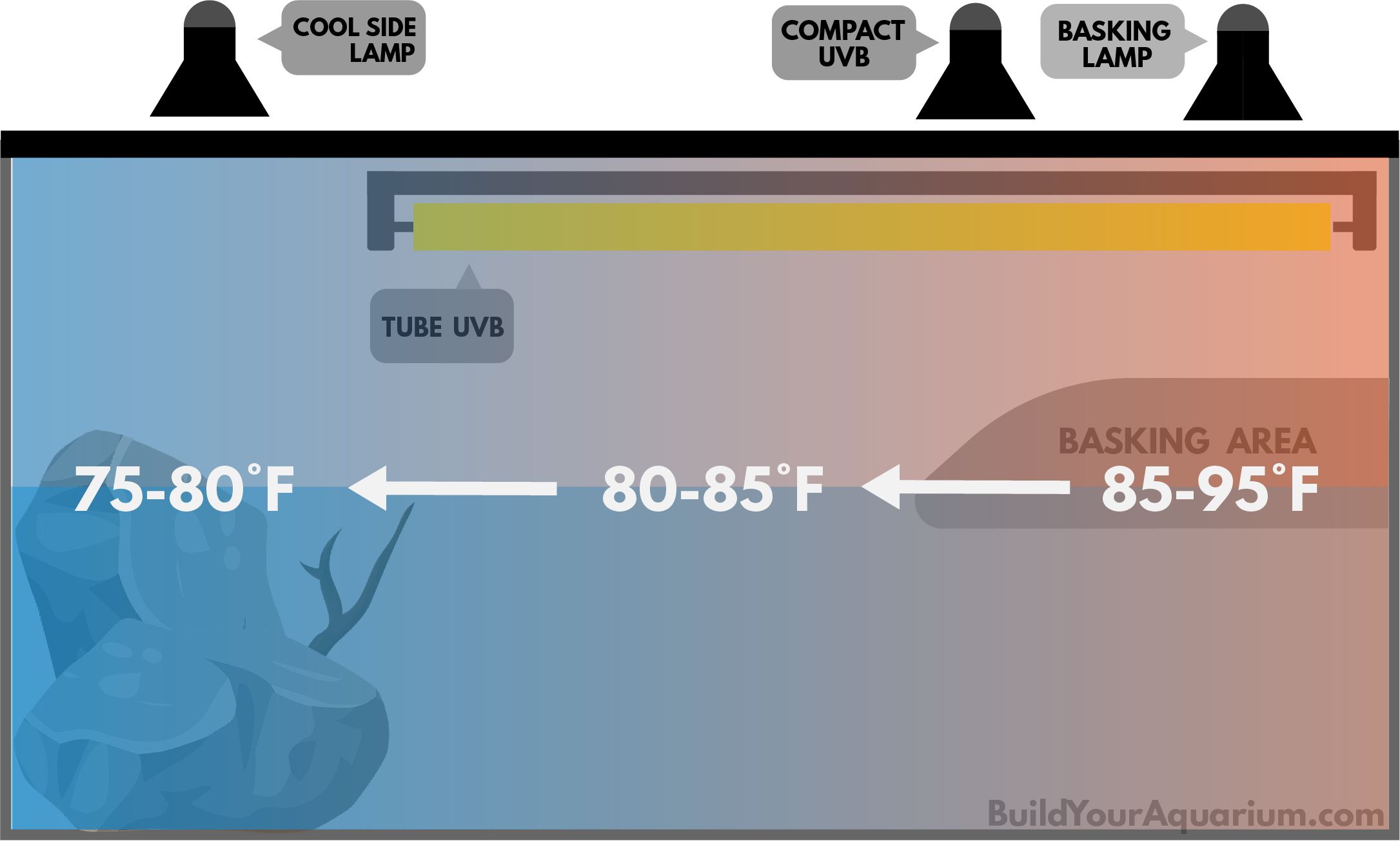
Make sure to find out the exact temperature range that'southward recommended for your turtle species.
Heating the basking expanse is done past mounting a oestrus lamp directly higher up the space.
Your turtle should take a range of warm temperatures inside the basking infinite, with the hottest spot existence directly under the low-cal. This way, your pet can move around as needed to better regulate its body estrus.
When shopping for heat lamps, y'all'll find different wattage ratings. Read the specifications about each bulb to figure out which i will provide the right temperature for the turtle species you have.
The closer you identify the bulb to the basking space, the hotter it volition be. Take care not to place it close enough that your turtle would be able to reach it and get burned.
Certain types of bulbs – incandescent, halogen, and mercury vapor bulbs, to exist exact – can become very hot. They tin even break if they come into contact with water. If y'all utilise one, make sure the embrace on your tank is sufficient to protect your turtle from glass shards if this were to happen.
You'll also demand another thermometer to monitor the temperature in your basking area.
Turtle Tank Lighting
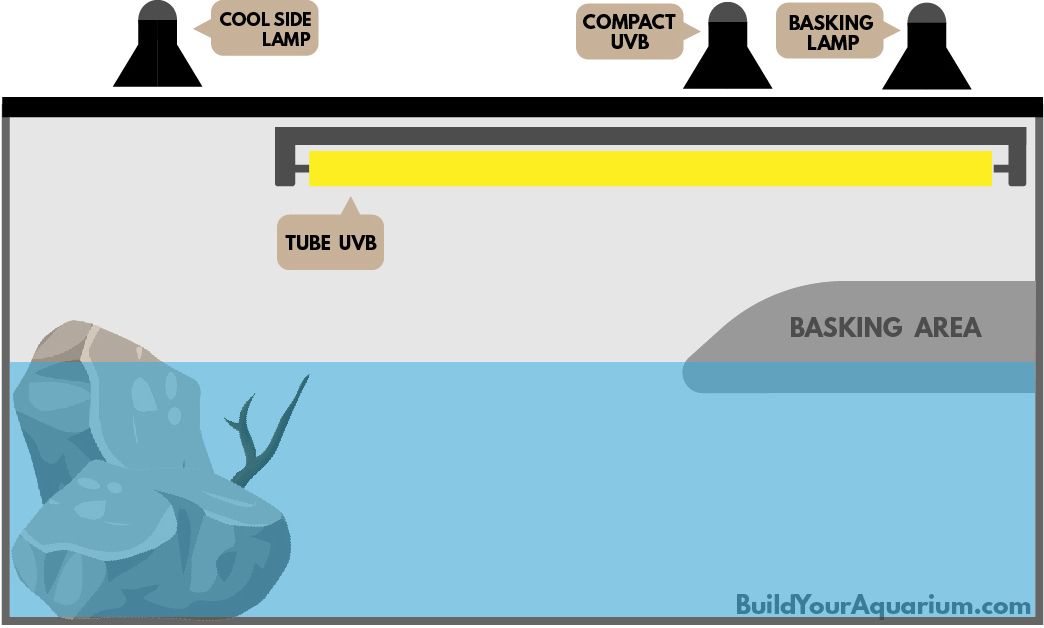
Aside from the heat lamp, y'all'll also demand to have UVA and UVB lighting for your turtle tank.
- Daily exposure to UVA low-cal is essential to the turtle'south ability to regulate its mood, to feed properly, and to breed.
- UVB lighting is necessary for Vitamin D3 production, which is vital for healthy bone and crush growth. Without it, your turtle can't procedure calcium and other key nutrients. As a result, it can develop metabolic bone disease, a painful and potentially fatal disorder. Note that UVB calorie-free cannot penetrate drinking glass, another reason wire mesh covers work well for turtle tanks.
Y'all accept a lot of choice in bulb types. As long as they provide the right spectrum for your turtle's health, the type y'all choose is upwardly to yous.
Yous can purchase fixtures such equally the one below that accommodates both a oestrus lamp and a UV seedling, which can save infinite and money. These tin be placed straight on top of your estrus-resistant tank encompass or mounted but above the tank.
Your little turtle also needs to have regular light cycles. You lot'll have to mimic daytime and nighttime past turning the lights off and on accordingly. Generally speaking, turtles should have around 10 – 12 hours of "daylight" per day. Installing a uncomplicated timer tin automate this procedure and ensure a consequent cycle for your pet.
Viewing Lights
While not necessary for the health of your turtle, you may wish to purchase a daytime viewing low-cal. This is simply some additional lighting to aid yous go a improve await within your turtle tank. There are several options for this, just many turtle lovers recommend using an LED light for this purpose. This is because LED lights are commonly well-baked and bright, last a long fourth dimension, and don't utilize much electricity.
You tin can also get a nighttime viewing light if you want to check out your turtle and its habitat during nocturnal hours. Be sure you get a light made specifically for this purpose, as they are specially designed to illuminate the tank without disrupting the turtle's day/night calorie-free wheel.
For more than lighting information, bank check out our turtle tank lighting guide. Information technology covers everything you lot demand to know well-nigh setting up the right low-cal organization for a turtle tank.
Other Things You May Need
Hither are a few other things you may need when setting upwardly a turtle tank:
Turtle Ledge
A ledge is a place for your turtle to come upward out of the h2o to dry off and bask. As previously mentioned, yous can create your own using logs, rocks, or other materials. You can also purchase ready-made ledges at pet stores or online. If you go the DIY route, exist certain the materials you apply are clean and sanitary. Information technology's likewise of import to make sure at that place are no precipitous edges that could harm your turtle.
Turtle Ramps
If your basking platform doesn't provide an piece of cake way for your turtle to climb onto it, you may desire to add a ramp to your setup. As with ledges, there are plenty of prepare-made ramps available at pet stores and effectually the internet. Y'all can as well make one yourself – just follow even so precautions you would with a DIY basking setup. If you make your own ramp, examination it out to brand sure it's sturdy before allowing your turtle to use it.
Rocks and Decor
Y'all may want to clothes upwards your turtle tank with boosted rocks, branches, and other decor items. This tin help you make the tank more similar your turtle'south natural habitat, and it can be more fun to observe your turtle in an attractive tank that has some interesting decor items.
Hiding Spots
Turtles enjoy having a couple of places to hibernate. You tin employ rocks, logs, other decor items equally hiding place for your turtle.
Plants
Plants tin can await great within a turtle tank. Yous can use real plants or fake ones, but go on in heed that it tin can be expensive and time consuming to try keeping real aquatic plants alive. On the other hand, some alive plants can help support a healthy nitrogen cycle in the tank.
A Few Words About Tank Décor
Anything you put within your tank will take up space that could otherwise be used for swimming or basking, so be sure non to crowd your pet with besides many objects.
Fully enclosed decorations items aren't platonic, since turtles tin can hands get stuck inside them. These items are designed for small fish, not turtles.
Substrate – Yes or No?
Calculation substrate to your turtle tank is not necessary unless you're using a UGF. Beyond that, it'southward purely a matter of your personal preference.
Hither are the different materials that can be used as substrate in a turtle tank.
- Sand: Sand tin can be a suitable substrate for turtles, though it can be difficult to keep clean.
- Gravel: Gravel, or small rocks, tin look really dainty and natural inside your turtle'southward habitat. If you lot utilise gravel, make sure to utilize a diversity that is at to the lowest degree ½ inch in diameter. Whatever smaller and your turtle could consume it and go injured.
- Fluorite: Fluorite is really crystallized cubes of calcium fluoride, which tin be benign for growing plants in the tank. Only similar with gravel, make certain the crystals are not small plenty for your turtle to ingest. You tin can also mix fluorite with gravel.
- Coral: Crushed coral is sometimes used as a turtle tank substrate, especially for saltwater or stagnant water turtles. Even so, crushed corals may not be the right substrate if you lot promise to grow rooted plants in the habitat. Coral tin can also modify the pH of your h2o, so do make sure you know what you're getting into if yous choose to use coral for your substrate.
You volition have to keep whatsoever substrate yous utilise clean, which will add to the level of maintenance required to care for your turtle tank.
Cycling Your Turtle Tank
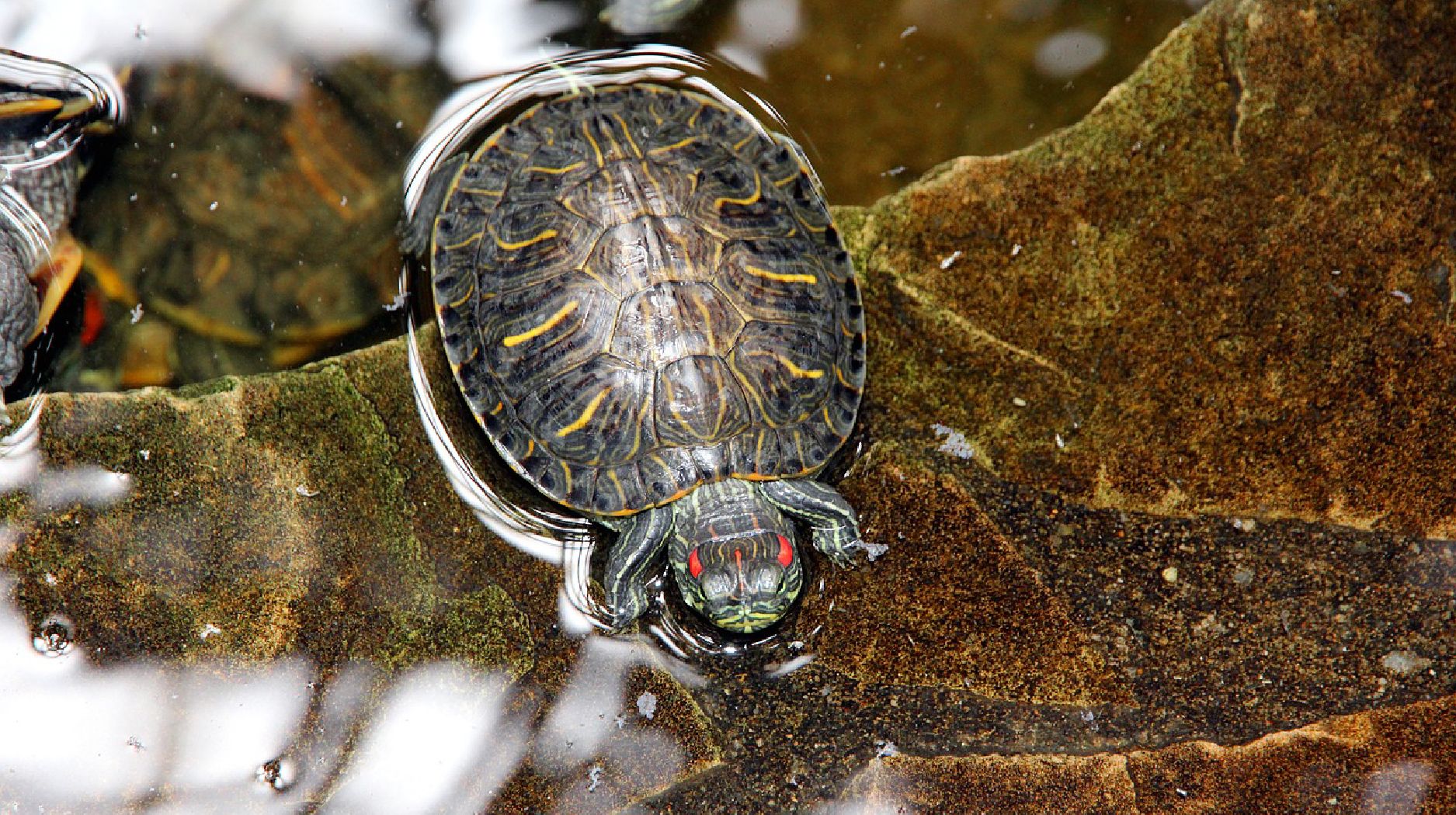
You've selected, purchased, gathered, and fix all of the elements of your turtle tank. Now what? Before you lot can introduce your pet to its new habitat, yous will demand to do what's known as cycling.
What Does "Cycling" Your Tank Mean?
"Cycling" is a procedure by which you'll cultivate the growth of beneficial bacteria in your tank, thereby keeping the water only right for your turtle's health and well-beingness. In this case, "cycle" refers to the nitrogen cycle which occurs in a healthy aquatic environment.
Here's how the cycle will work one time information technology'south all gear up up:
- The waste matter from your turtle causes ammonia to be released into the water. (If allowed to accrue, this ammonia would be toxic to your turtle).
- One type of bacteria (Nitrosonomas marina) will assimilate the ammonia and convert it to nitrite.
- Nitrite is also harmful for your turtle. That'south where a second type of bacteria (Nitrobacter and Nitrospira) come in to play. These gobble up the nitrite and turn information technology into nitrate.
- Nitrate, in small amounts, is non harmful to your turtle (and regular h2o changes will exist sufficient to proceed the nitrate levels within a good for you range).
When this process is complete and seems to be relatively cocky-sustaining, your tank is considered "cycled."
Once cycled, the ammonia and nitrite levels in your tank should be at or very near zero.
Your nitrate level should be no more than 40 ppm. The pH should be between 6 and 8 to support these helpful bacteria and your turtle.
Your aquarium filter will contain some of these nitrifying bacteria, though non enough to support a good for you turtle habitat. You will have to grow the population of bacteria to optimal levels before yous can introduce your turtle to its tank.
How to Wheel Your Tank
Cycling was once commonly done by but adding a few live "feeder fish" to the tank to become the process started. Those first fish would create the waste necessary to grow the tank'southward bacteria population. Unfortunately, they would often get sick and dice as a result of living in water with loftier ammonia and nitrite levels.
What is a "Fishless" Wheel?
A fishless cycle is just a way of cycling your new tank without using live fish.
There are a couple of ways yous can do this.
You can innovate ammonia directly into the tank to increase the bacteria population.
Alternatively, you can add fish nutrient or only plain one-time fish from the grocery store to your tank; either will somewhen break downward and produce ammonia. The keyword in that final sentence is "eventually," every bit cycling your tank this way will take longer than the straight-ammonia method. Also keep in mind that it tin be messy (and a bit smelly).
Before you lot practice either, make sure your filter is up and running and that you take a water testing kit on paw.
- A few days later calculation either the pure ammonia or your called organic matter to the tank, begin testing the ammonia levels in the h2o.
- During the beginning stage of the cycle, you lot should aim to go on the ammonia level around 3 ppm. This level should periodically dip, as the bacteria grow and brainstorm to consume more. Continue adding ammonia (or fish food, etc.) to the h2o to raise the ammonia levels support.
- After a week or then, the ammonia-eating bacteria should brainstorm to produce measurable levels of nitrites. When you see this happen via your testing equipment, y'all'll know the wheel has actually begun. Keep calculation ammonia to maintain well-nigh 3 ppm.
- At some signal after this, y'all should run across a drop in nitrites and an increment in nitrates. This indicates that the tank has almost completely cycled. Now, continue testing until the ammonia and nitrite levels have zeroed out, and the nitrate levels are stable.
- If yous detect elevated ammonia levels at any point afterwards introducing your turtle, you lot can option up an ammonia neutralizing production from the pet store.
Generally, cycling takes around vi-eight weeks. If you want to brand things move a lilliputian more quickly, you can introduce leaner from an already-established tank if you have admission to i. The most common way of doing this is by placing used filter media from the good for you tank into yours. This does nowadays the risk of introducing unwanted organisms into your aquarium, so be certain y'all know you're using media from a well-maintained tank.
Introducing Your Turtle to the Tank
After you've successfully cycled your tank, it's time to introduce your pet to its new home! Here are a few tips for minimizing stress during the procedure.
- Place your turtle gently into the tank; don't drop it in.
- Never pick up a turtle by its legs or head. Like most living creatures, turtles don't peculiarly enjoy this. Plus, you could cause a serious injury.
- Give your new pet some time and infinite to become accustomed to its new surroundings. Turtles don't always love being handled, especially turtles that are already adjusting to existence in a new place around new people.
- Proceed your water testing kit handy, taking regular measurements to ensure that proper cycling has continued later introducing your turtle to the tank.
Caring for Your Turtle
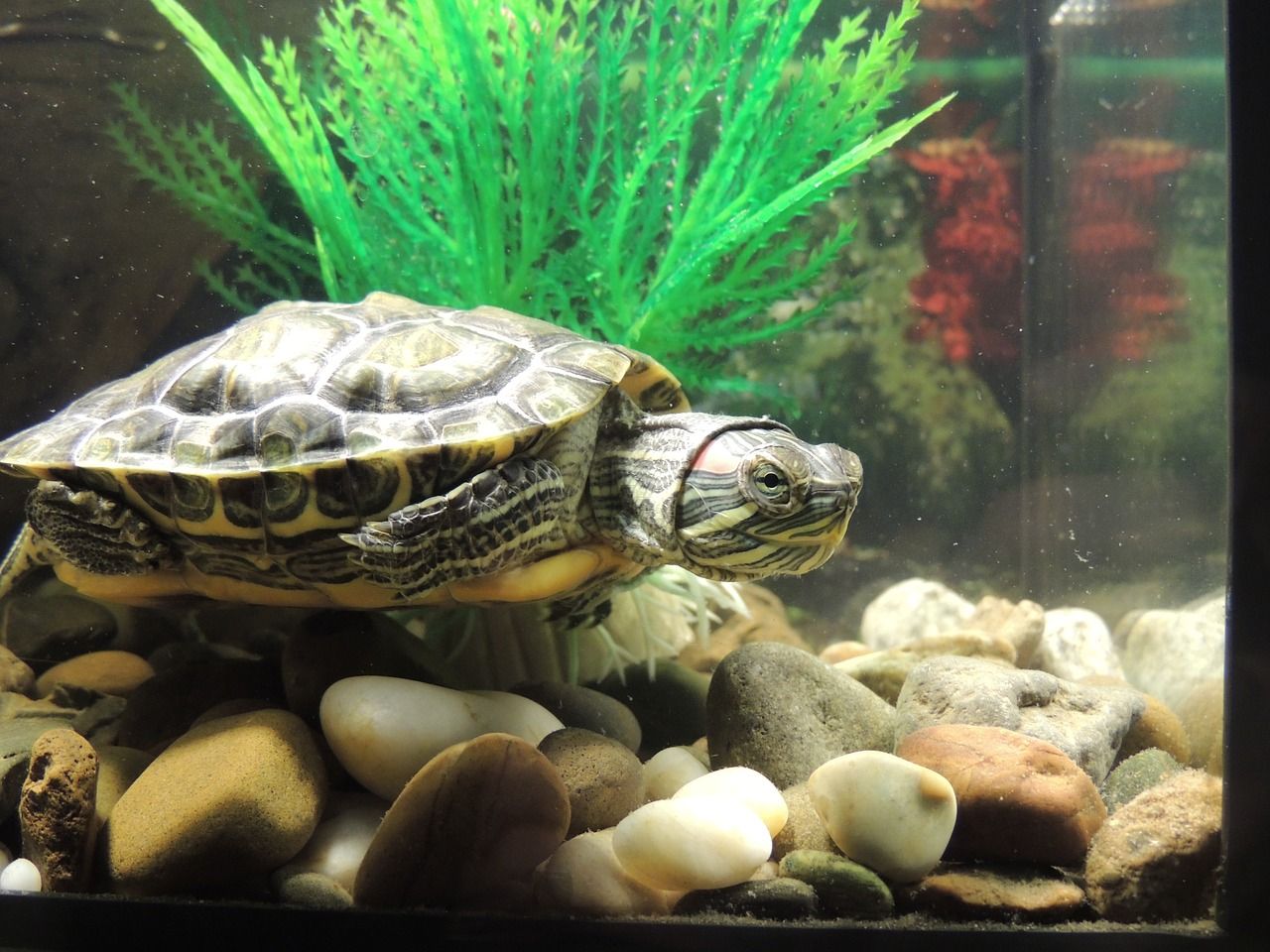
Taking care of a pet turtle and watching it grow and thrive is an amazingly rewarding experience. Proper care is as well necessary for turtles to live long, happy, and healthy lives. Hither are the basics of turtle care.
Diet and Nutrition
Your turtle's exact diet volition depend on what species it is. Some are herbivores, meaning they only swallow fruits and veggies. Omnivorous turtles like to have some meat with their salad (commonly in the form of small fish or insects).
Produce: All turtles need plenty of fruits and vegetables in their diet. The following are safe for them to eat:
- Mustard Greens
- Kale
- Collard Greens
- Berries
- Apples
- Melons
- Carrots
- Squash
Remember to chop or shred any fruit or vegetable yous feed your turtle.
Fish and Insects: Omnivorous turtles should exist given protein-rich food like crickets or pocket-sized fish. You can also buy freeze-dried insects, though it's best to give your trivial buddy fresh food whenever possible.
Pellets: Prepare-made pellets y'all discover at the pet store can be a nutritious office of your omnivorous turtle's diet. Not all turtle pellets are created equal, though. Bank check the label and select pellet food that contains a high percentage of protein (effectually 40% is good) and a low percentage of fat (shoot for less than 8%).
Supplements: You lot'll need to make sure that your pet is getting plenty of calcium (it takes a lot of the stuff to build and maintain that strong, bony shell!). The best way to exercise this is by sprinkling a powdered calcium supplement on the fruits and vegetables you serve.
A Few More Things Almost Feeding Turtles
- For omnivorous turtles, around 50% of their nutrition should come from produce. Live food and pellets can brand up the other half.
- Herbivorous turtles can eat an all-produce diet, but should have significantly more vegetables than fruit (about fourscore% veggies, 20% fruit).
- Omnivorous baby turtles will demand a higher protein diet than adults, and may not swallow much produce until they are older.
- If you're not certain whether your turtle is getting all the right nutrients, it's a good thought to check in with a veterinarian who tin provide personalized advice for your pet. Always defer to your vet's expertise when it comes to feeding and caring for your pet. He or she may recommend additional supplements or other means to rest your turtle's nutrition.
- Baby turtles will eat every day, simply an adult only needs to exist fed 4 or 5 times per calendar week.
- Don't feed your turtle table scraps (unless it happens to be some scraps of kale or shredded carrot sans dressing), and don't requite turtles dog or cat food.
Temperature
Go on to maintain healthy temperatures within the unlike areas of your tank. Cheque your equipment oftentimes to make sure it's all working properly.
Humidity
Make sure humidity levels in your turtle'southward habitat are optimal, also. Exactly what "optimal" means can vary depending on the kind of turtle you accept. Keeping the humidity too high or too low in your tank can crusade your turtle to develop health problems.
Maintaining Your Turtle Habitat
You'll also be responsible for keeping your turtle tank clean and well-maintained. The water will need to be changed regularly, and you'll also accept to clean out your tank periodically – even if yous have a really powerful filter.
Here are some tank-cleaning tips:
- Unplug whatever electric devices, such as your filtration and lighting systems, before cleaning your tank.
- Make sure your turtle is in a prophylactic place while you make clean the tank.
- Kids should be supervised when cleaning a turtle tank.
- Never clean your filter or other tank components effectually places where food is stored, prepared, or eaten. Turtle habitats can harbor harmful germs and bacteria.
- Apply rubber gloves when cleaning your tank, for the reasons stated to a higher place.
This could be the first of a beautiful friendship. It takes some work, but the rewards of having a pet turtle are far greater than the efforts.
Source: https://www.buildyouraquarium.com/turtle-tank-setup/


0 Response to "How To Set Up An Aquatic Turtle Tank"
Post a Comment